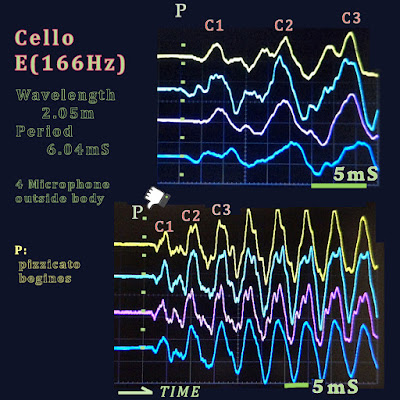[ 11/20/2023 ] Labels: 78.Resonance3
Cello resonance,, it can be divided into four processes.
[1] The string begins to vibrate
[2] The top plate shares the information and starts vibrating itself.
[3] Density waves are emitted into cello body by receiving vibrations from the top plate.
[4] Resonant waves inside the body are transmitted to the outside of the body to audio microphones.
Let's take a look at the actual measured data at four audio microphones installed near outside the body. To begin with the resonance simulation, we examine the E note first, the tone has a frequency of 166Hz and a wavelength of 2.05m, which exists about the middle for a cello tones. This sound is the most typical and simplest omnidirectional sound, and is estimated to resonate in a "8-shap" orbit pattern parallel to the top and back plates.
[3][4] The process travels through the atmosphere at the speed of sound. Therefore, a time of about 3mS should be required here. On the other hand, the first resonance (C1) surprisingly occurs and completes 4 mS after the start of pizzicato.
[1] As soon as the string begins to vibrate, the information of the period(frequency) and wavelength of the generated sound are already decided in the string, and transmitted to the top plate in a timely manner.
[2]So, the top plate also knows the information in a timely manner. Top plate may know the range to be vibrated, in which direction, and with what intensity. At this time, the second resonance wave C2 has not be born, and the resonance has not been amplified in the body.
Even with limited prior knowledge, there are some hints. The Montagnana(1740 model/dimension) was used in the simulation. The maximum single "8-Shaped" wavelength can be adopted in the body at D# (around 156Hz), which is the next(lower) to E. The vibration range(probably 94% of D#) can be used at E(166Hz).
チェロの共鳴を考える時、4つのプロセスに分けることができる。
[1]弦が振動を開始する
[2]その情報を表板が共有し、表板が振動を始める
[3]表板の振動を受けて密度波を筐体内に放つ
[4]筐体内の共鳴波が筐体の外(音声マイク)へ伝達される
筐体の近くに設置された4点の音声マイクロフォンの実測データを見てみよう。手始めは、周波数166Hz, 波長2.05m, チェロにとってちょうど中間あたりのE音を調べる。この音は最も代表的・シンプルな無指向性音で、表板・裏板に平行に8の字型に共鳴していると推定される。
[3][4]プロセスは大気中を音速で伝わる。従って 3mS程度の時間はここで必要なはずだ。一方最初の共鳴(C1)は驚くことにpizzicatoのスタートから4mSに起こり完結している。
[1]弦は振動が開始されると同時に 発生される音の周期(振動数)・波長情報を保有し、タイムリーに表板に伝達を開始していて、表板は筐体へ共鳴を作り始めていることを意味している。
[2]表板もどの範囲をどの方角にどだけの強度で振動させるのかわかっていること示唆している。この時、共鳴波の第2波C2はまだ発生しておらず筐体内に共鳴は増幅されていない。
限られた予備知識の中でもヒントはある。シュミレーションに使ったMontagnana(1740)モデルのチェロでは、EのとなりのD#(156Hz付近)で筐体の取りうる最大の8の字型の波長をとる。表板が生成すべき振動域はおそらくE(166Hz)はD#の94%の大きさでよいはずだ。




